Do you want to learn voice leading in music?
Voice leading is an essential component of modern-day common practice tonal music, where you arrange your notes of the chords in chord progressions so that their smooth linear relationship and interaction results in beautiful harmonies.
In this article, you will learn part writing, different voices in four-part writing, voice ranges, different melodic motions, rules of melody and spacing in part writing, objectionable parallels and other troublesome intervals in different motions, voice leading for triads in root position and the 7th chords.
Read the complete article below for a clear idea about voice leading today!
Introduction to Voice Leading
In simple terms, voice leading refers to the arrangement of the notes in the chords to maintain a smooth linear relationship between them in chord progressions. A more technical definition will be “the melodic linear progression of voices or parts and the interaction between these voices to create harmonies,” usually in line with the rules of the tonal music and counterpoint.
The conventions in tonal music require the individual voices or melody lines to move independently of each other and smoothly. This independence is achieved by avoiding parallel movement in the intervals of fifths or octaves. The smoothness requires conjunct motions to either avoid leaps or follow them with step movements in other directions and manage the tendency tones properly.
The rules of counterpoint are also related to the intervals you should avoid in any individual voice, the intervals between the notes of the voices, and their relative direction of motions.
As you may know, we refer to counterpoint as the relation between two or more individual voices which are independent in rhythm and the contours of the melody but harmonically interdependent.
The rules are a little different in classical music and jazz. We will discuss them in detail in the sections below.
Don’t worry if this does not make complete sense to you now. You will understand all this and the related concepts by the end of the article as we move step by step in introducing the related concepts.
What is a Voice or Part in Music Theory?
As per the definition above, voice leading is related to the continuity and smoothness in the movement of any note as it moves from one chord to the other. In a way, all the notes of the chord move or lead to the notes of the next chord.
We also defined the counterpoint as the weaving together of independent melodic lines to create harmony. The different melodic lines may be played by four independent musical instruments or sung by different singers.
The composer must choose the individual notes in each melodic line carefully so that they may sound good when played together. Listening to two melodies can be confusing, like listening to two simultaneous conversations, unless they are specifically coordinated and constructed.
Aligning the two concepts, the notes of the chords are treated as voices or parts that are combined to have the independence and smoothness in a chord progression we talked about. This comes from different chord voicings and economy in motion. Simply, it is the art of combining individual concurrent musical lines.
What is 4-part voice leading?
The four-part voice leading, or SATB, refers to the four-part chords written for four voices – Soprano (S), Alto (A), Tenor (T), and Bass (B). The four-part voice leading is called the “chorale-style” voice leading.
If you use three-part chords or three voices, they will usually be SAB, or Soprano, Alto, and Bass, leaving out the Tenor.
The Soprano and Alto are notated on the treble clef, while the Tenor and Bass are notated on the bass clef. In a piano-style voice leading, however, the three upper voices are usually on the treble clef, and only the bass voice is on the bass clef.
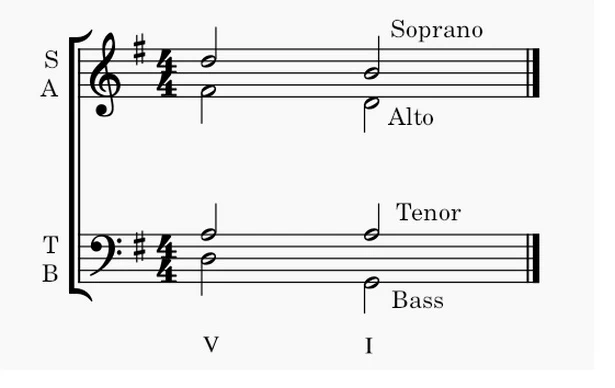
The Soprano and Bass are known as the outer voices being the highest and the lowest in pitches, while the Alto and the Tenor are the inner voices.
Voice Ranges
The ranges for the different types of voices discussed above are:
Soprano – It is the highest voice overall. It spans from the C to G, as shown on the treble clef, an interval of Compound Perfect fifth, or CP5. CP5 is an interval that is a perfect fifth above the octave. This interval is for the choral settings. It can be higher if you are soloing. On the piano, it is from the C4 to the G5 key. The note symbol stems up on the clef.
Alto – The second highest voice that spans from the G to D on the treble clef, as shown, with its stem facing down. The interval is again a compound fifth that lies between the keys G3 and D5 on the piano.

Tenor – The second lowest voice that lies between the C and G notes on the bass clef (as shown), with its stem facing up. Again a compound fifth interval between the keys C3 to G4 on the piano.
Bass – The lowest voice that stems down on a bass clef. Bass voices range between the notes E to C on the bass clef and E2 to C4 on the piano, an interval more than the CP5.
Types of Motion
You have seen the definition and the main concept behind the counterpoint in the section above. You will now go through the different types of movements or melodic motions that two or more voices can go through relative to each other.

- Static motion: When none of the voices change the notes and remain static. This should be avoided. A better option is to have the previous notes played for longer durations.
- Oblique motion: When out of two voices, one is static, while the other voice moves towards or away from the static one by a step or a leap. The motion ensures the independence of the voices.
- Similar motion: When both the voices move in the same direction, up or down, but each with a different interval. The movement may be a leap or by steps. This is sometimes referred to as direct motion.
- Contrary motion: When the voices move in opposite directions to each other, whereby one goes up, and the other goes down.
- Parallel motion: It is a special case of similar motion, where the melodic motion of two voices has the same interval. This means that they move in the same direction, up or down, and by the same intervals.
What are the rules of voice leading?
You will now be presented with the smooth voice-leading rules, also known as the preference rules or the classical voice-leading principles. These rules are generally categorized into two types or sets, the first set is associated with the melody and the second with the spacing between the voices.
The rules associated with the melody have their origin in building singable melodies and summarize melodic practices in music.
Rules of Melody
The classical rules associated with a good melody are given below. Each voice is expected to follow these rules and be independently good melodies.
- The rhythm must be simple. A rhythm is said to be simple if each has a fairly equal note value without huge variations. The preferred values are between the half notes and the eighth notes.
- It is preferred to have all the harmony notes within the chord tones.
- There must be only one focal or the high point of the melody. While you can always have some peaks and valleys on your way up or while coming down, all should be in line with this single highest point in the music section.
- Melody has two types of motions – a conjunct and a disjunct motion. The conjunct motion is limited to a movement by a maximum of a whole step, while a disjunct motion is in leaps. You must not leap by any augmented interval, 7ths, or more than the octaves.
- A leap larger than a 4th or a leap by any diminished interval must be followed by a change in the direction and movement in steps. The leaps create tension, and when the step movement fills the space, it satisfies the listener and releases the tension.
- You should avoid consecutive leaps. If unavoidable, they must outline a basic triad.
- The tendency tones in any diatonic scale are the scale degrees other than the tonic, mediant, and dominant notes, which are a crucial part of the overtone series. The scale degree 7 resolves to 1(8), the octave, while 4, in most cases, resolves to 3. The other tendency, tones 6 and 2, normally resolves down by a step to 5 and the tonic note.
Rules of Spacing
The rules associated with the spacing between the different voices are outlined below:
- The voice ranges must be respected.
- The spacing between the Sporano and the Alto voice should not exceed one octave.
- Similarly, the spacing between Alto and Tenor is also limited to a maximum of one octave.
- However, the spacing between the Tenor and the Bass can be higher than one octave but is limited to a compound fifth.
- Anything more than these specified spacing is known as a spacing error.
- No crossing is allowed between the voices in any chord. Hence the order SATB must be followed. Alto cannot be higher in pitch than Soprano. Tenor cannot be higher than Soprano and Alto. The Bass has to be the lowest pitch. Always check between the Alto and the Tenor, as maximum crossing errors happen between these two.
- No voice overlapping is allowed. This occurs when a higher voice in the first chord goes down below the lower voice in the second chord. The opposite can also happen. This may happen even if the voices are within their defined ranges. You should always check for overlapping, as it may be a little difficult to spot.
- The voicing is said to be closed if the top three parts (SAT) lie within one octave and there is no gap between them. It is open if the top three parts are spread more than an octave, and it is possible to accommodate a note between them.
- If we use three-part writing for a chord, the spacing should be less than or equal to an octave between Soprano and Alto and a compound fifth or less between Alto and the Bass note.
Objectionable Parallels and Issues in Other Types of Motions
In addition to the spacing rules, you must follow certain additional rules when dealing with parallel motions, known as objectionable parallels. Further, there are certain intervals to be avoided in the other types of motions as well. These are:
- You should not have any two parts that move in parallel unison, parallel 5ths, parallel octaves, or parallel 12ths (CP5) from one chord to the next. It is thought that such movements infringe upon the independence of the parts. Any consonant interval is not to be played in parallel.
- Parallel thirds and sixths are considered acceptable. You may avoid fourths, if possible. Seconds and Sevenths are generally not used.
- In contrary motion, you should not move from a Perfect 5th to Perfect 12ths (like a CP5 interval) between any parts, specifically the tenor and the bass. Similarly, check for a perfect octave by contrary motion.
- The parallel and contrary motions P5/P8 can happen between any of the voices, so you need to check all six combinations in total. These are T – B, A – B, S – B, A – T, S – T, & S – A.
- In similar motion, you may face issues with either the direct/hidden Perfect 5th and Perfect octaves or the Unequal 5ths.
- The direct/hidden 5th and octaves are only associated with the Soprano and the Bass parts. It happens when a similar motion has a leap in the Soprano and results in a P5 or P8. Particularly, you have to be careful in consecutive leaps.
- The unequal 5ths is where a diminished 5th interval moves to a Perfect 5th by a similar motion. This issue is a concern only between the bass and any other part.
Other Considerations in Classical Voice Leading
There are a few other considerations in classical voice leading that you must be aware of and are touched on below:
We already stated that the individual melodic lines must be independent and an interesting melody in itself. There is what some call the economy in motion, which requires you to retain as many common tones in the harmonic progression as possible and move by steps, where required.
First, look out for the common tones in the chords played and retain them.
Next, figure out a way by selecting parts positions so that each voice in a chord moves by a small distance limited to a step only. Avoid leaps as far as possible. This is done as long as none of the preferred rules listed above are violated. The lowest note, or the bass, can jump by a 3rd or a 5th.
In chord voicing, try to have a contrary or oblique motion between Soprano and Bass if possible.
The Contemporary and Jazz voice leading do not have as strict rules as classical music, but the economy in motion, smoothness, and independence is also respected there.
Let us see what voice leading means practically and how it is actually carried out by examples of triads and 7th chords that we commonly encounter in our music.
Voice Leading Root Position Triads in Four Parts
The basic triads have three notes. So to write them in four parts, you can double the root of the root position triad. The exceptions to the doubling are:
- In the final chord in the piece’s progression, you can omit the Perfect 5th note and triple the root.
- When dealing with the deceptive cadences with V – VI or V – vi progressions, double the third note instead of the root.
You can now look at the cases of voice leading from the tonic chord in a major scale in root position to the ii, iii, IV, V, and vi chords, followed by the deceptive cadences in the major and minor scales. Since you are taking the root position of the chords, there will be leaps, but you must try to keep them to a minimum by following the above-laid-down rules.
Movements to iii and vi Chords
These chords belong to the tonic family and have common tones with the tonic chord. Hence, in these two cases, while the bass line will leap by a 3rd and a 6th, there are two common parts, which you can retain and move the third upper voice by a step. The voice leading is shown in the grand staff diagrams below.
In the C major key,
- The iii Chord: The C major chord is voiced as [C G C E], and the iii chord, the E minor, is voiced as [E G B E]. Out of the upper three parts, the G and E are common, while C moves to B.
- The vi Chord: The first chord is voiced as [C C E G], and the vi chord, the A minor, is voiced as [A C E A]. The C and E notes are common, while G moves to A.
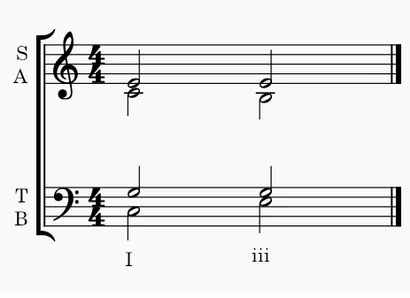
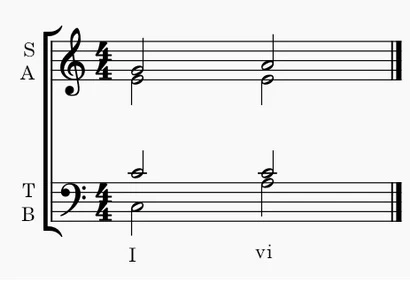
Movements to IV and V chords
In the upper three parts, there is only one common note, and the other two are different. There are two ways to voice lead these chords.
A. The first method involves retaining the common note and moving the others by a single step. This is shown in the diagrams below.
Again in C major,
- The IV Chord: The C is voiced as [C C G E], and the IV, the F major chord, is voiced as [F C A F]. In these, the C is the same note in two chords, while G moves to A and E moves to F.
- The V Chord: The C chord has notes [C C G E], and the V chord, the G, has [G B G D]. G is the common note, while C moves to B and E moves to D.

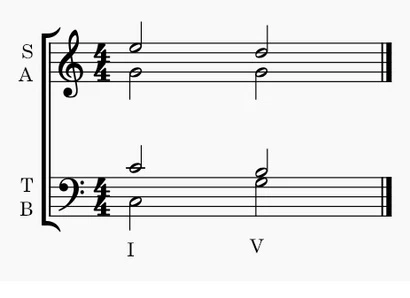
B. The second method involves the movement of all the 3 upper notes by a 2nd or the 3rd interval in a similar motion. These are shown in the diagrams below.
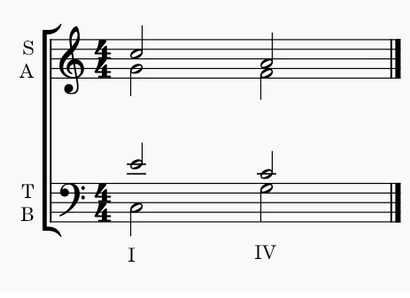
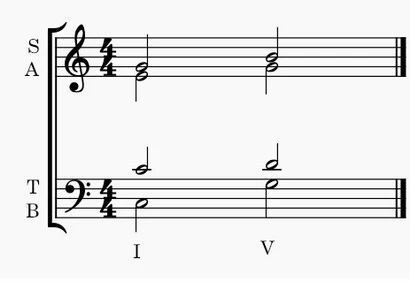
The Movement to the ii Chord
In this case, the upper three tones are moved in a contrary motion to the movement of the bass notes, as shown in the diagram below.
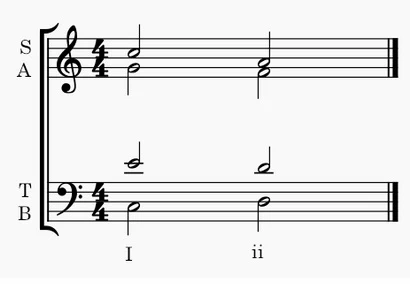
Voice Leading in The Deceptive Cadences
The deceptive cadence between the V – VI chords is usually dealt with by doubling the third note, as stated earlier and shown in the diagram below. Note that the 3rd note of the V chord is the leading tone in the outer voice. It has to resolve up. If you do not have a doubled 3rd, the outer leading tone has to resolve downwards, which is in violation of the above rules.
Similarly, the deceptive cadence V – vi is shown in the diagram below. If you do not have a double third instead of a doubled root, you will end up with an augmented 2nd terminal, which violates the rules above, as no augmented intervals are allowed.
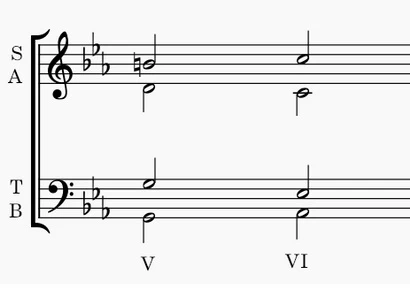

Voice Leading Seventh Chords
The main single rule relating to the voice leading of the 7th chords is to resolve the 7th of the chord down by a step. The other parts must move in a smooth manner to the nearest chord tones. The voicing with appropriate doubling should be selected.
Conclusion
Hopefully, you liked the above article and got the required information. If you want any clarifications on the topic or have comments on the article, you are welcome to do so in the comment section below. I will try to respond ASAP.
